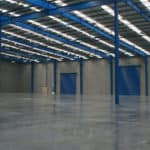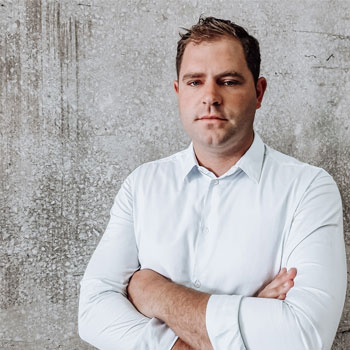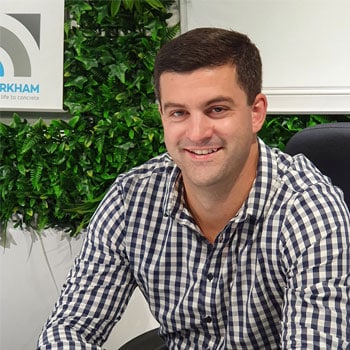Here’s a matter-of-fact discussion about the challenges faced by warehouse floors, and the options available to help protect them. Why is a warehouse floor at risk? What are the drawbacks of commonly used protection methods? And what does Ben recommend?
Protecting Warehouse Floors

Invisible Strength
Protecting Warehouse Floors
/
RSS Feed
Protecting Warehouse Floors
Boral article referred to boral.com.au/sites/default/files/media/field_document/The%20Boral%20Book%20of%20Concrete.pdf Page 19
Warehouse floor protection markhamglobal.com/floor-slab-protection-2
Rejuvenating a warehouse floor? markhamglobal.com/rejuvenating-a-warehouse-floor
View the Transcript
BRAD: G’day everyone! Welcome to the latest podcast episode from MARKHAM’s Invisible Strength series. Today we’re looking at Warehouse Floors – what are the challenges, and what are the options?
I’m Brad Fulcher, Project Consultant from our Sydney office. And joining me virtually is Ben Dowell from our Perth hub. Ben, let’s hear from you!
BEN: Yes, thanks, Brad! Yes, I head up operations and sales in Western Australia. I’ve been with the company for three years now, and in that time been exposed to a wide range of projects from new constructions, through to old structures that we’ve remediated. Yes, thanks for having us on board. Hope we can have a good discussion about these warehouse floors.
BRAD: Right, that’s great, Ben. So you’ve got a world of expertise there. So let’s start thinking about new warehouse floors now. What are the challenges we need to think about when designing or putting in new warehouse floors?
BEN: Well, there’s a variety of different challenges that, you know, warehouse floors are faced with. Obviously your live loads or your storage loads. Either can be a big issue when designing a slab. And the durability of the floor. So how long the floor’s designed for, really, and its service life needs to meet the design life of the structure itself. And that is where we probably play a big part in extending that.
BRAD: Sounds good, OK, so give us your worst-case scenario then, that you might have seen – what happens when concrete isn’t durable?
BEN: So what we’ve seen, I mean, a couple of scenarios that we’ve remediated post-pour, is cracking and delamination. So your top or your surface of your concrete slab has come loose and come off, and once that it happens, you end up with an exponential rate of deterioration; through to that area of the slab not being usable.
And also if the slab isn’t protected from the outset, you end up with a pretty, well, a sped-up process of wear and deterioration, which causes dusting; whether it’s so-called, a fabrication warehouse or something, where you’ve got people working on it fully; that can be an issue these days with silicosis. And also with sensitivity, if it’s a storage warehouse and you’ve got sensitive goods stored in there, that can be an issue also.
BRAD: Yes, good. I’m guessing it also has to be costly and time-consuming to remediate these slabs during an operational period of the warehouse. Yes, good to get it done right the first time.
BEN: Yes, that is right and that leads into a few different areas. So you’ve got shutdowns for repair, and when you are repairing a slab you can never get it back to its original state, and from then on you’ll have problems with that slab. That’s just a couple of points to note there.
BRAD: Yes, exactly! So what are the common methods that you see being used to help this in the industry?
BEN: The most common one’s probably paint or surface epoxy coatings. Whilst these are good when they’re operational, they don’t last, so you generally only get a certain amount of time before … depending obviously on what the facility is used for; but these only usually last for a certain amount of time, and they need to be replaced, which is another costly exercise – removing existing and replacing.
Shake on hardeners; once again, these will only really last for a time, and they do put stress on the slab when applied at time of pour, because they are competing with the moisture that’s in the slab to produce what they produce, the densifying of the surface.
And that’s really the problem with these things they’re only at the surface, so they’re only protecting the surface of the slab. They’re not integrally right through the slab or set up within the slab matrix, so they can be damaged or removed pretty easily.
BRAD: Now that sounds important, to make sure that the hardener or whatever you’re using will last the distance. Just on that, with a deep penetrating treatment, what would you recommend?
BEN: Well, we’ve had a lot of success with our hydrogel treatment. We get penetration up 150mm into the concrete. So you’ve got 150mm of the concrete matrix that is fully protected. So in the event that if it [the slab] is used heavily and the concrete itself is physically removed, by destruction or something happening to it, the slab itself is still protected. So with this penetration and the hydrogel setting up that far into the concrete or the slab itself, you can think of it pretty much like we’re embalming the concrete; so it is protected whatever happens.
With the hydrogel treatment, if applied early – so at curing stage or same day as pour, it has a curing benefit, so it’s equal to having the slab wet cured for 14 days. Obviously reducing shrinkage cracking and bleed water porosity, keeping that … Basically what we do is turn the moisture in the slab into a hydrogel, thereby locking it in the slab, giving the concrete or cement particles maximum hydration; which in turn gives you a far more durable slab. So we basically gave the concrete the best chance it’s got from the outset.
BRAD: That sounds perfect! With curing, we’ve always seen it, and many concrete industry leaders always say, that durability starts with curing. Noticed actually the other day on an article by Boral Concrete where they compared curing with water cure compared to just air curing, and the concrete that was air-cured had about half of the MPa strength of the properly cured concrete. It points up how important that is.
BEN: It is a pretty integral part of the whole process. And – I don’t know how to put it into words – but at that stage of the project on the day of the pour, it is a very easy part of the pour, really, to overlook. Because you’ve got the pre-mix supplier who supplies the concrete; obviously the concrete placer who does an excellent job of that, but once they finish placing the concrete curing is not really on their radar.
BRAD: Brilliant, no, definitely good to point that up. Next note, what sort of warranties does this carry for that asset owner or the builder?
BEN: Yes, so good question. If we are supplying applying our hydrogel system, typically 15-year warranty. We like to take control of the application just so that we know the system has been applied in the correct manner for the correct specification where our rates have gone on. That leads us to confidently hand over a warranty for 15 years.
But once it is applied correctly at the time of pour, and set up in the concrete, it really can never be removed. So unless the concrete itself is completely destroyed, our system will be in the concrete.
BRAD: Nice! Well, what about compatibility issues? You often see some curing compounds being removed at the back end of a project before they can do line marking or any paints for zone demarcations. What can you say about that?
BEN: That is a good question, and we probably get asked about it every project. There are many different types of adhesives, paints, surface sealers, that get applied to various areas of a warehouse. And what we generally find with ours is, because it’s … our hydrogel systems are colloidal silica-based, so it’s of the cementitious family. We’re not adding anything foreign into the concrete, so what we’re adding really produces more of what concrete is. We generally find, and we have done … a lot that I’ve worked on, they end up with better adhesion, because the surface isn’t dusty. We’ve given them a dense surface to adhere to with either their paints or surface epoxies and that kind of thing; so that it actually ends up a win-win for the client.
BRAD: That makes sense. Things are only as strong as what they are sticking to. So what about safety? You’ve done a lot of these applications over in Perth.
BEN: Yes, so we’ve worked pretty heavily lately with the Green Star Council of Australia. All the products are nil-VOC so they are completely safe to handle. There’s no health risk or anything like that. There’s also no risk to the environment as well. There are some other products on the market – crystalline silica; the chlorinated rubber also; which are highly hazardous and dangerous to the environment and to the user. So what our product aids in is providing that a safe scenario for the applicator, so at the time of application, and then also throughout the concrete’s life, there’s nothing hazardous that’s been added to concrete that’s going to affect anyone further on down the stream. And we are working, I believe at the moment, as I said before, with the Green Star Council to be able to provide… or help work towards the Green Star rating when we are involved in the build.
BRAD: That’s great, there’s a lot…more and more Green Star builds coming out, which is great to see.
It’s great to hear your enthusiasm, Ben! It’s been great being with you. Thanks very much for going through that with us. And to all our listeners, get in touch if you’d like any more information. Our contact details are at markhamglobal.com – jump on there. There’s plenty of information and downloads available. Have a look around and please ask us any questions you might have.
Have a great day and do not miss our next episode coming up next!
Want to Contribute?
Feedback on our podcasts? Suggestions for future topics? Looking for more information on topics we’ve discussed? Send us a message – we’ll be in touch within a day or two.
More about MARKHAM
MARKHAM are dedicated to providing innovations for concrete and construction. Focusing on concrete waterproofing solutions, penetrating concrete sealers and durability treatments for concrete.
Podcast Categories
Latest Episodes

Doug & Laike Share Their Week – Western Australia, Christchurch, and a Focus on Low Carbon Concrete
Laike and Doug wrap up their week again with a 10-minute chat. They’ve each been

Doug & Henry Share Their Week – R&D, Melbourne Traffic, Basement Waterproofing, And ‘CONQOR Your Health’
It’s Henry’s turn to join Doug in the podcast studio – in person this time!

Doug & Laike Share Their Week – Seychelles, Readymix Plants, And A Bike Ride
Once again Doug and Laike sit down for a 10 minute recap from the week.
invisible strength podcast
The whole MARKHAM team is pleased to present you with our podcast series, INVISIBLE STRENGTH. In this series of interviews, we’ll walk through the science and challenges of concrete durability, what goes wrong in the field – and the advanced methods available to restore and enhance service life to concrete construction.
INVISIBLE STRENGTH reflects a number of factors in concrete construction and durability. When things go wrong, the evidence can become very visible indeed. However, when all is going well, there’s nothing particular to be seen!
MARKHAM’s concrete treatments, too, are invisible once completed – and the result is the long internal, invisible durability of the concrete.
So join us as we explore the unseen world inside concrete – why it matters, and how it can be protected!

